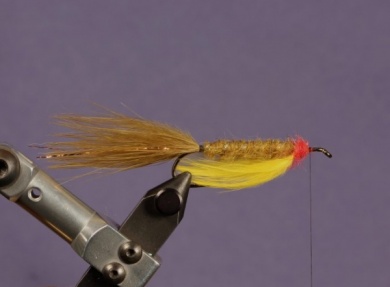Rabbit strip flies are an effective aid when we go for big emotions while streamer fishing in the fall. The way the strips move in the water and the size they give to flies are very special, all kinds of trout seem to be attracted to them, even when they aren’t biting, and especially if the angler View more...Rabbit strip flies are an effective aid when we go for big emotions while streamer fishing in the fall. The way the strips move in the water and the size they give to flies are very special, all kinds of trout seem to be attracted to them, even when they aren’t biting, and especially if the angler gives dynamic moves to these flies. Strip Leeches come from the New Zealand Rabbits, the first to have rabbit strips. These have changed over time, getting bigger, with tails and legs; sometimes being more effective. But the original Taupo Lake models still remain formidably effective. Maybe the leech name can confuse us because we tie these flies mainly to imitate fish, but it isn’t rare for this to happen in fly fishing. Take the deadly Adams, today used to resemble mayflies, but born to imitate certain caddis. Truth is we would have to wait for trout to talk to know what makes them take these flies; we would surely be surprised and would have to bury some dogmas. Many of us tiers have trusted in the powerful lure of a rabbit strip when going for big trout. Today’s leech is refined from several seasons; it comes from a G. Borger leech. It has given me amazing results in sizes 6 from 2. I tie the wings in black, brown, olive, yellow or white and change the colors of the marabou belly and tail as well as the front hackle. It’s important to add the lead weight so it works correctly, horizontally, without tilting its head as it happens with bead heads. I see that the jig effect of a weighted head makes big trout wary; I prefer a streamer that swims and escapes like real minnows. That way I only focus on the angle of the escape, which can vary in different types of water.
Move the mouse over the image to zoom in the fly.
Touch the image to zoom in the fly.

List of materials
Hook: Daiichi 2220 or similar Thread: 8/0 color: similar to the body. Weight: lead wire Tail: olive Marabou Flash: Flashabou, copper color Body: Whitlock SLF dubbing blend, color sculpin olive. Listing: oval Tinsel, broad, golden Belly: yellow Marabou Gills: STS trilobal dubbing color red Wing: rabbit strip, black Hackle: grizzly hen, dyed of the color coachman brown. View more...Hook: Daiichi 2220 or similar Thread: 8/0 color: similar to the body. Weight: lead wire Tail: olive Marabou Flash: Flashabou, copper color Body: Whitlock SLF dubbing blend, color sculpin olive. Listing: oval Tinsel, broad, golden Belly: yellow Marabou Gills: STS trilobal dubbing color red Wing: rabbit strip, black Hackle: grizzly hen, dyed of the color coachman brown.
Steps
Step 1
Carefully tie one or two marabou feathers, add 2 strands of flashabou at the sides of the tail.
Step 2
Place the lead wire. Im using a # 4 hook with a 0.15 inches wire. 0.20 can work too for fast waters. The weight in the middle makes it swim straight.
Step 3
Tie the tinsel leaving some space in the back for the wing.
Step 4
Make a cigar shaped body using Whitlock SLF dubbing, color Sculpin olive. Use a double turn to make it better.
Step 5
List the body with no more than 6 turns, like an open spiral. This doesn’t move backwards like closed or tight spirals. The secret is to push the spiral towards the front, not upwards.
Step 6
Use a wire brush to loosen hair for better transparency and moves. Then Add the marabou belly.
Step 7
Use dubbing STS Trilobal Antron for the gills.
Step 8
Cut the rabbit strip tip (like a V) and tie before the gills. I add some cianoacrilate enamel where the wing will be tied. So it doesn’t turn rounds later.
Step 9
Tie the grizzly hen by the tip.
Step 10
With the hen feather make a hackle of 6 turns combing it towards the back so it bends correctly. Tie it and cut the thread away.
Step 11
Reconnect the thread in the tail section.
Step 12
Wet the rabbit strip so you can open it easily. Tie it with 15 to 20 turns ending with a knot in the head. Cement carefully, only the thread must be cemented. A pin helps with this task.Wet the rabbit strip so you can open it easily. Tie it with 15 to 20 turns ending with a knot in the head. Cement carefully, only the thread must be cemented. A pin helps with this task.
Step 13
Apply lacquer layers in the head to finish our fly.










